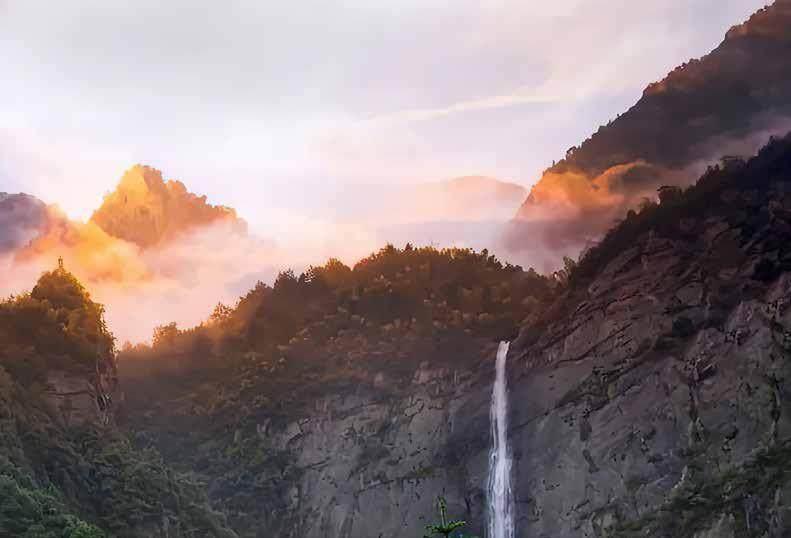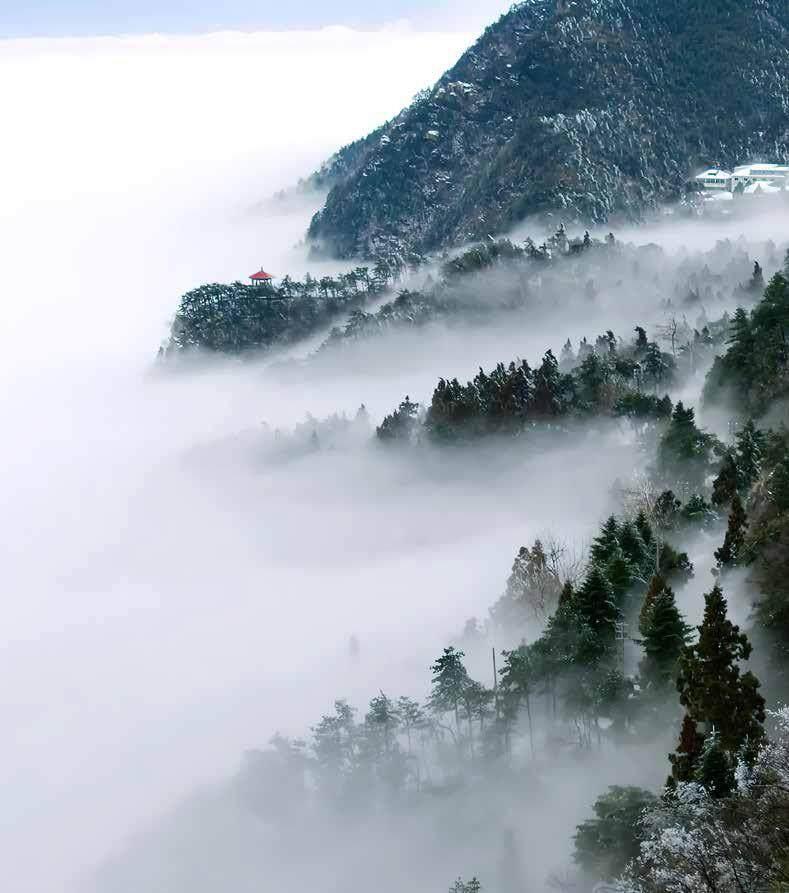不识庐山真面目Of Mountain Lu We Cannot Make Out the True Face
崔高浩



“不识庐山真面目”是一个汉语成语,形容“对客观事物的认识还不全面,没有认识到事物的真正本质”,在日常表达中也用“庐山真面目”来表示事物的真相或某人本来的面目。
“Of Mountain Lu we cannot make out thetrue face” is a Chinese idiom used to describe “anincomplete state of understanding of an objectivephenomenon, with its true nature left unprobed”. Indaily speech, “the true face of Mountain Lu” is alsoused to connote the true nature of some thing orperson.
该成语出自宋代大文豪东坡居士苏轼(1037—1101)所作的《题西林壁》一诗,后半句是“只缘身在此山中”。
The idiom is a line from the poem “Written on theWall at West Forest Temple” by the renowned SongDynasty poet Su Shi (1037–1101), or Dongpo Jushi(Jushi being a moniker for learned scholars duringthose times). The idiom is followed by another linein the poem: “For we are lost in the heart of the veryplace.”
《题西林壁》
横看成岭侧成峰,
远近高低各不同。
不识庐山真面目,
只缘身在此山中。
Written on the Wall at West Forest Temple
Its a range viewed in face and peaks viewed from the side,
Assuming different shapes viewed from far and wide.
Of Mountain Lu we cannot make out the true face,
For we are lost in the heart of the very place.
這首诗是苏轼在1084 年(北宋神宗元丰七年)游览庐山后所作,题中的“西林”指的是位于庐山西侧、名为西林寺的一座寺庙。当时苏轼受贬,改迁汝州团练副使,前往汝州时途经九江,与友人同游庐山,写下了这首《题西林壁》。
This poem was written in the year of 1084, which is alsothe 7th year in the Yuanfeng calendar during the reign ofEmperor Shenzong of the Northern Song Dynasty. It wascomposed after Su Shis visit to Mountain Lu. The name “WestForest” was the name of a temple located at the western sideof the mountain. At that time, Su Shi was demoted and exiledto a post that only carried a nominal title in Ruzhou city. Onhis way there, he passed by Jiujiang city and visited MountainLu with friends. The poem was a result of that visit.
苏轼吟咏的庐山是一座什么样的山呢?庐山位于江西省,长约25千米,宽约10 千米,山体呈椭圆形。数十座山峰连绵不绝,似屏风一般,主峰为海拔1 474 米的汉阳峰。周武王时期,名为匡俗(一说“匡裕”)的贤者隐居于此,朝廷听闻后派人请他出山,但匡俗却隐匿消失,只留下了他的空茅庐。因此,庐山被称为“有庐舍之山”。从古至今,无数文人墨客、艺术家等各界名士前来参观,得道高僧和著名道士也在此修行。无论在哪个朝代,庐山都是一座充满了浓厚文化氛围和雅趣的名山。
What is the real Mountain Lu like then? It is located inJiangxi Province, with a breadth of 25 km and width of 10km, in the shape of an ellipse. Consisting of a span of tensof mountains, it stands there like a folding screen, of whichthe main one, Mount Hanyang, climbs as high as up to 1,474meters. During the reign of King Wu of Zhou Dynasty, ahermit sage named Kuang Su (or Kuang Yu) lived in thisarea. The Zhou court heard of his whereabouts and sent forhim. However, Kuang Su disappeared, leaving behind only
an empty cottage. As such, Mountain Lu is called a“mountain with Lu cottages”. Across different historicalperiods, many literati and artists paid their visits here,including reputed Buddhist monks and Taoist priests.At any given dynasty, Mountain Lu was praised as asymbol of strong cultural character and refined taste.
廬山山势雄伟、山清水秀、风光旖旎(yǐ nǐ)、三面临江,由于周围都与江水相接,故山上常年云雾弥漫,人们很难看清楚它的真实面貌。
Mountain Lu is known for its magnificent height,enchanting scenery and mesmerizing view. As its footstretches into the adjacent river in three directions, itsmountain top is surrounded by clouds and fogs, thusgiving people a hard time to glimpse a clear view of itsfull geological features.
苏轼的《题西林壁》,用平易凝练的语句描绘了庐山。其中“不识庐山真面目”将哲学道理寓于诗中,后来成了一个大家熟知的成语,越是反复咀嚼( jǔ jué),越给人以深刻启发。
Su Shis poem “Written on the Wall at West ForestTemple” depicts Mountain Lu in a plain and simplelanguage. The third line “Of Mountain Lu we cannotmake out the true face” embeds a philosophical thesisand later on develops into a common idiom known byeveryone. The more one chews on this line, the moreinspired one is to become.
我们常说“人在森林深处,就无法看清整片森林”。比如,下象棋或围棋时,在一旁观看的人比下棋的人更容易看清棋局。这也就是中文里所说的“当局者迷,旁观者清”了。作为当事者,我们有时很难全面、客观、多角度地去看待一件事。
As a common saying goes, you “cant see the forestfor the trees”. For instance, when you are playing chessor Go, the ones who stand aside the actual players aremore at an advantage to grasp the whole situation.In Chinese, we have a corresponding saying: “Thoseinvolved in the matter are easily blinded to the truth,and those not involved can see things clearly.” If wehappen to be directly involved in a situation, it is at times difficult to approach it comprehensively,objectively and multifariously.
游览在雾气氤氲(yīn yūn) 的庐山,随着脚步前行,各不相同的山脉、山峰和名胜都在变化,而且被雾气笼罩的山势也朦胧不清。有人认为,庐山只有像屏风一样延绵不绝的山峰;有人认为,大瀑布就是庐山的全部;还有人认为,在高峰上观赏到的云雾才是庐山真正的面目。若想一睹庐山的真面目,就要从雾气笼罩的山中走出来,既要往前看,也要往侧看,或许只有这样才能勉强看到庐山的真容。假设用“横看”和“侧看”比喻视角,用“雾”比作主观和先入之见,那么要像拨开山中笼罩的浓雾一样来摆脱主观和成见,既“横看”又“侧看”,并从各个角度客观地看待不同的情况和问题,才能看到它们的真实面目。
As one treks through the cloudy and foggymountain range, every climb to a peak introducesa changing view of interest, adding another layermeaning to the mountains ambiguous ambience. Somepeople believe Mountain Lu is all about the sprawlingmountain range that stands like a folding screen; somepeople believe the giant waterfall is the true essence ofthe mountain; other people believe the clouds and fogsas one gets climbing up the peaks are the true face ofMountain Lu. However, if one truly wants to get a fullview of this giant, they have to walk out of the cloudymountain roads and divert their vision both forwardsand sideways. Only in such a way can one manage toget a rough glimpse of its true face. If we see lookingforwards and sideways as metaphors for perspective,the fog then represents ones pre-conceived notion ofthings. What is needed therefore is for us to dispel ourpreexisting biases when looking at things, the sameway one would walk out the fog to see Mountain Lu.To grasp the true nature of various circumstances andproblems, we need to retain both forward and sidewayperspectives to ensure that we can approach them in amultifarious and objective way.

